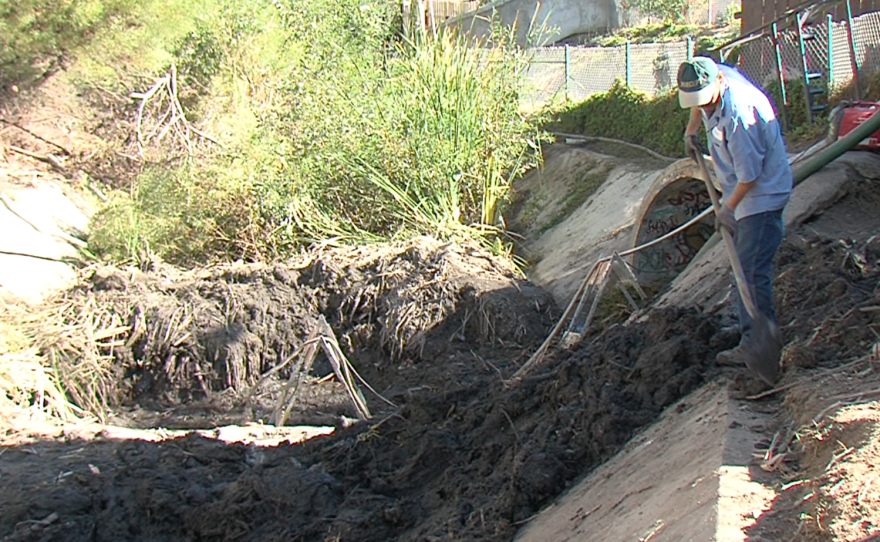With a rainy El Niño season looming, San Diego Mayor Kevin Faulconer and 18 other regional leaders in San Diego County have asked Gov. Jerry Brown to declare a state of emergency, and that has some environmentalists worried — particularly when it comes to the city of San Diego.
If Brown approves the declaration as requested, it would suspend various codes that could "prevent, hinder or delay" flood preparation efforts throughout the county, according to a Nov. 23 letter sent to the governor by the region’s mayors and a county supervisor.
The letter also says state and federal environmental regulations "have substantially impaired the ability to maintain flood control channels and other storm water management infrastructure."
San Diego’s position is that the state of emergency is needed to protect people’s homes and lives, but the city’s past track record on clearing storm channels has made some environmental leaders skeptical.
Travis Pritchard, interim executive director of San Diego Coastkeeper, said he was disappointed that the city had not done a better job maintaining its storm channels within the environmental review process.
"I think they’re using (El Niño) as an excuse to do things that they’ve been wanting to do without the environmental regulation," Pritchard said.
He also questioned decades-old decisions in San Diego to build on natural flood plains — notably Mission Valley. He said he suspects the city was now trying to "place blame on the environmental community for flooding that is just due to poor planning and poor infrastructure building."
When it rains, pollutants on streets are washed into the city's storm channel system, which eventually flows out to the ocean. The vegetation that sometimes clogs storm channels also acts as a natural filtration system, making the water that ends up on San Diego's beaches cleaner. Vegetation and sediment can also create habitats for wildlife, even in urban areas.
To clear out the vegetation from storm channels, cities needs permits from up to six government agencies that supervise water quality and wildlife. Cities also have to devise ways to mitigate the impact on the environment. Those can include installing artificial water filtration systems, more frequent street cleaning and restoring wildlife habitat in other areas.
San Diego's Five-Year Plan
Livia Borak, a lawyer with the Coast Law Group, was part of a 2010 lawsuit against San Diego over the city's multi-year plan to manage its storm water system.
The lawsuit alleged that the city's environmental review was insufficient. The California Coastal Commission agreed, and the two sides reached a settlement in 2013 that limited the scope of the master plan from 20 years to five years.
Borak pointed to the lawsuit as evidence that the city of San Diego has an imperfect track record of striking the right balance between flood protection and respect for the environment.
"We certainly understand the risk to life and to property that flooding poses," Borak said. "We’re a little suspicious that they’re trying to do all these channels right now on an emergency basis when it’s not something that happened overnight."
Stephen Vincent owns Titan Exchange Sales, a business on Engineer Road in Kearny Mesa next to a storm channel. He said his building’s management has tried for years to get the city to clear out vegetation that is clogging the channel.
"I don't understand why they can't just keep them cleaned out every couple of years," he said.
84 Miles To Manage
San Diego has 84 miles of storm channels — some man-made, and others naturally occurring rivers and streams. The channel on Engineer Road was at the top of the city's list of priority storm channels to clear but has since dropped in urgency. Kris McFadden, director of the city's storm water department, said El Niño has shifted the city's priorities extensively.
"Things that maybe didn’t need to be dredged for a couple years now, because of the predicted rain event, are a higher priority," McFadden said. "And we’re shifting resources in order to accommodate that."
McFadden said it can take up to two years to study a channel's ecology, apply for clearing permits and complete mitigation efforts.
"Because of the endangered birds in these areas, we can only clean the channels during the rainy season," he added. "When those regulations came into effect, that actually reduced the ability for us to clean channels by 50 percent."

The San Diego City Council declared a state of emergency because of El Niño on Nov. 16, allowing city agencies to expedite their review of storm channel maintenance. A California state of emergency could suspend environmental regulations at the state level, but not the federal level. The letter to the governor also asks him to request federal regulations be suspended as well.
McFadden said flood control always has to be balanced with environmental concerns, and that even under a state of emergency, the city would still have to assess and mitigate the environmental impact of its work. Those efforts would simply wait until after the work is done.
"Every time we do a channel clearing, we put it out for public notice and public review to get any input," he said. "So actually I think this is probably the most robust and most environmentally sensitive channel clearing that I'm familiar with."
Borak countered that the environmental review and mitigation efforts can’t possibly be as strong if they're completed after the storm channel clearance is done. But she agreed with the city government on at least one thing: San Diego has to protect people's lives and property.
The governor’s office is still considering the request for a state of emergency.






